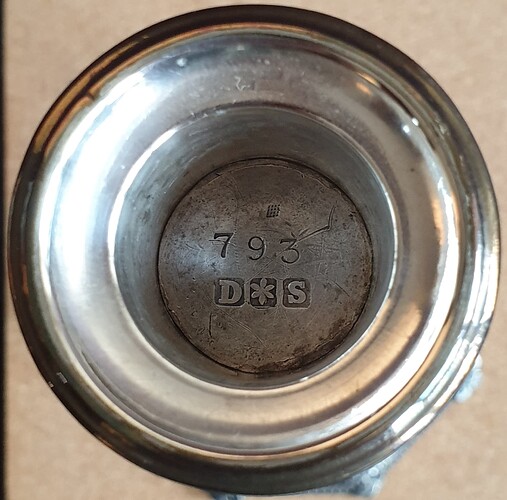My dear friends! I have two James Dixon & Sons candlesticks in my collection. The set is strange because both are made in different techniques - one is PNS, the other - PGS. However, I am intrigued by the grid symbol (first photo, above the pattern number). I would be grateful for any tips, or maybe even ready answers…
And I know, looks like Creswick or Hutton, but it’s not. 
Photo of whole item, please.
The celebrities are silent… Significant.No offense. 
Are you sure there are no other marks on the piece? Examine the top rim and the rim of the base carefully.
Jeff, thank you for your interest and willingness to help. I inherited the candlesticks from my father. At first glance, they look like a set, but they differ in the signatures I have already mentioned. I will take a picture of them today to make it easier to solve the problem.
1 Like
I don’t understand what “problem” needs to be solved. These candlesticks are not a “set.” They were produced by the same maker, using the same pattern, but at different times. Somewhere along the line, the makers decided that PNS - plated nickel silver - didn’t sound as fancy as PGS - plated german silver, or vice-versa, and changed the marking. They’re the same thing, so it was just a marketing ploy.
As far as the little grid stamp is concerned, we know that silverplate makers put all sorts of unregistered marks on their pieces, usually in an attempt to convince buyers that they were getting something unique or special, rather than an inexpensive, mass-produced item. In most cases, the marks don’t have some meaning that has been lost in the mists of time. The markings never meant anything in the first place.
1 Like
The photos show the only signatures visible to the naked eye. I have carefully examined both candlesticks with a magnifying glass. There may be something under the cloth glued to the bases, but I will not rip it off. The color of the cloth indicates that this is a set, but I am relying on the opinion of experts on the subject.
“…I am intrigued by the grid symbol…” 

The cloth indicates nothing. Originally, the candlesticks probably didn’t have any cloth on them at all - that green felt might have been added much later. And crooked, to boot. Or, if they were sold with green cloth, it may have been replaced, after getting wet, for example.
I’m still mystified about why you think these are some sort of matched pair. Think this through. Why would the maker of inexpensive, mass-produced silverplate candlesticks produce a pair that had different markings on them? What would be a possible rational explanation for this?
The grid pattern almost certainly means nothing at all. You’re on a snipe hunt.
1 Like
![]()











